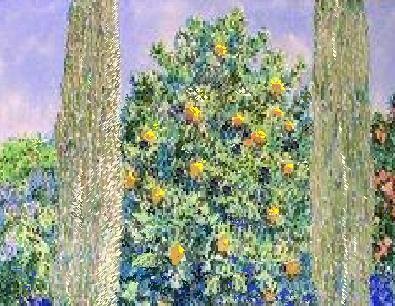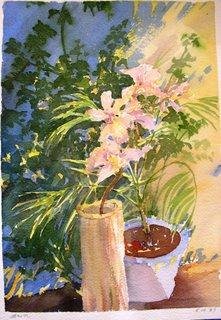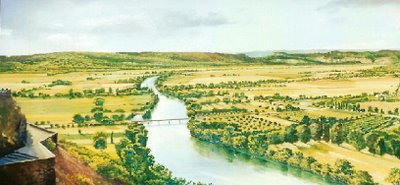Tuesday, October 31, 2006
Sunday, October 29, 2006
Fear & Loathing, 1972 - 2006

Hunter S. Thompson is dead for one thing. Habeas corpus too.

Richard M. Nixon/Lyndon B. Johnson, 1968, oil on canvas, 32x28 inches, (detail)
From the collection of Marsha and Mike Skinner
The government letter with the 4-5 classification came on June 6, 1968, the 24th anniversary of D-Day, the day Robert Kennedy was assassinated, the day my mother would die 13 years later.
In 1972 I was a lucky young man from a fortunate and loving family living at the far end of Western civilization. An intelligent and beautiful young woman loved me. We lived in a decidedly romantic enclave of the contemporary, and revolutionary culture. The moon had only a flag and footprints then. We were not hippies; we were not particularly radical. We were rather middle class expressions of our times, and our times like always, ruled the universe. We were good, we were smart and we loved music and dogs. Many of us were artists, and we’d begun to pursue that adventurous life along heavily trafficked routes and our own self-made roads.
“Publish it”, he said, “Run it with an essay by Hunter Thompson”.
“Ok”. I said, not knowing who the writer was or the depths of the waters I was treading, “Ok”… $350”.
“Whoa”, said Wenner, “I’ll give you $250.
“But uh…no”, I said, “you make me feel like I’m talking to William Randolph Hearst and worth it, I want $350”, and he laughed and said, “Ok, I’ll give you three”.
I took it.
Rolling Stone published Miss Liberty and later, another drawing of a nervous and sweating George McGovern for Thompson’s Fear & Loathing in New Hampshire, and they published three or four poem illustrations, but Ralph Steadman began drawing his brilliant cartoons for Thompson and my career as a political cartoonist came to an end.
Thursday, October 26, 2006
Tuesday, October 24, 2006
Some Flowers
Monday, October 23, 2006
The Crabtree's
 The Crabtree’s, watercolor on paper, app 9x11 inches, 2004.
The Crabtree’s, watercolor on paper, app 9x11 inches, 2004.From the collection of Jessica and Chris Moland
This is the old Crabtree house. Out on the road to the race track, runs around Rocky Hill to Doyle Colony at the Springville Highway, past the old rodeo grounds; the road turns there by the district cemetery, what is it called…oh yes, Putnamn Avenue.
The new high school, they built it out there. The house is just across the street from the new high school.
It’s East Olive now. They call that stretch of Putnam East Olive.
There were lots of Crabtree’s in Springville. This place was built by Thomas Jasper Crabtree, same tree, the other branch, for his parents James Abraham and Paulina Moreland Crabtree with proceeds from sale of their mining claims at Mineral King, in about 1903.
That hill on the left is Worth, the long one trails off to the right is supposed to be Success. Most of the blue mountains here are part of The Reservation, then south into Deer Creek.
Dad would've asked about the power poles, wonder where they were, ask why I left them out.
All the boiled egg clouds and not a line for a bird to sit.
Wednesday, October 18, 2006
Down the Dordogne
Tuesday, October 17, 2006
L'aube de Cap d'Ail, 1990
I stayed in the poolhouse, whatever it was, no villa but better, down at the end of the promenade, away from the students and just below the German family who drank from their balustrade. Villa Thalassa. La Violetta.
It is my favorite watercolor.
Rinaldo and Darrio showed me everything from then on, asked the questions, looked at all the pages in the portfolio. They made an altar. The Spanish saint, the Italian angels, the tiles from Toledo, the candles in the evening, all dusted with his ashes. We ate salty fish, got happily drunk, then turned into Romans and pretended to understand pre-Rennaissance perspective and I painted the scene for them later, the dramatic scene with all of us in it from the evening of this morning, I am so very fortunate.
Up Dennison

The painting was made for The Springville Inn, but bought by Mitch Burrell in Portland, who later sold it to John Everitt in Hood River.
Saturday, October 14, 2006
The Sleeping Leopard
I hunted quail here with my grandad in the late 1950's, then learned later, at a higher elevation, I could not shoot deer.
Kids go to school here now in the summer. They are bussed up from the Central Valley to learn the ways of nature at SCICON, (The Tulare County School of Science and Conservation).
This painting commemorates the successful 1970's fund raising campaign to purchase McDonald Hill, and so generally save the school in it's natural aspects, and specifically save it from the encroachment of a proposed housing development.
I was walking past the painted rocks in the lower pasture at Battle Mountain Ranch when the call came from the SCICON board of directors that they were ready to start the painting. We'd been thinking about it for a year or more, the time gave me the chance to think the painting out totally, so I saw it all, and it took 5 weeks to make. It is the biggest canvas I've painted, and it was painted in the smallest studio.
Mitch Burrell saw a photograph of the painting and tagged it The Sleeping Leopard.
Albany Hill, Dennison and Moses, Out the Window
 Dennison and Moses, watercolor on paper, app. 8x10, 2003.
Dennison and Moses, watercolor on paper, app. 8x10, 2003.Out the Window, watercolor and dyes on canvas, 30x42 inches, 1975.
These three paintings belong to Marsha and Mike Skinner. Marsha and Mike are old friends, especially Marsha, who suspects with good reason we are all related. Marsha and Mike bought the two small watercolors on paper from the 2004 show at the Bakersfield Museum of Art.
They bought the watercolor, painted on gessoed canvas, at The Walnut Creek Valley Art Center in 1975, from a show of a dozen or more paintings made and titled from the inspiration of a wild car ride with my cousin Ken at the wheel of his old red VW bug, his hands on and off the wheel while he drove and talked, and my hands clutching the dashboard and seat to hold on, my eyes glued to the landscape flashing by as it does when your moving through it at any speed over 30 mph.
We were traveling considerably faster; either up to Sonoma or back to San Francisco, down from Sonoma, or maybe a trip up to Corvallis, or down to Delano for me and Murray Hill for him. I also held a cup of coffee between my knees, a note book in my lap, and the ubiquitous cigarette, both legal and illegal, fresh Tareytons one after the other, the joint getting passed between us, then jammed into the overflowing ashtray with the gum wrappers.
1975. AM/FM radio. Brilliant conversation. Going somewhere. On the road, all that highway, all that color, land, sky, life and death and things and ideas and everything in here and in the car and out there, just outside the window.
These paintings were impressions, they were composed; expressed landscapes of a general nature. The technical chances I took with the paintings were extreme, and measured against what the paintings looked like fresh and what they look like today, I failed. The paintings faded. I was warned about transitive dyes and the risky chemical bond of watercolor on gesso. But I was foolish, hypnotized, addicted to the bright colors. The varnish has luckily held in the 31 years since application, a spit-wet finger won't pull the pigment, but the luminous color is gone, only the bones remain.
There is no defending my misuse of material. But the painting survives despite the fading: it seems to have moved through the seasons. The flaming violets of the blooming iris are gone, so are the bright greens and blues of the month in Spring those iris bloomed.
The painting is left a dried arrangement, a chalky drawing, a study of sere October, unlike the intentional autumn effect with the watercolor on paper, with real pigments, of Mt Dennison and Moses Mountain, dimly visible through the haze in a painting which will, presumably, if the painting lasts, and the universe lasts, fade over centuries rather than decades.
Albany Hill is what I look at these days, and the view here has literally changed since the watercolor was made. The old Bay Bridge in the middle distance, crossing over to Yerba Buena Island and the city is coming down, to be replaced in a few years by a newer version.
Wednesday, October 11, 2006
Pinole from El Sobrante 2006
 This watercolor is from Carol and Diane's deck in El Sobrante, I made it yesterday after lunch, looking east north east, or perhaps more north than east, looking out over the oaks in the yard to Pinole, the houses, the urbanizacion, then the hills to the Sacramento Valley. The painting is not finished, but I pulled the tape. I want to work on it, post the changes; we'll see what happens. It felt very good to drop the wet brush onto the paper.
This watercolor is from Carol and Diane's deck in El Sobrante, I made it yesterday after lunch, looking east north east, or perhaps more north than east, looking out over the oaks in the yard to Pinole, the houses, the urbanizacion, then the hills to the Sacramento Valley. The painting is not finished, but I pulled the tape. I want to work on it, post the changes; we'll see what happens. It felt very good to drop the wet brush onto the paper.Monday, October 09, 2006
Rag Gulch
 A half-sheet watercolor of the Quinn Ranch at Rag Gulch; painted in the early, the middle 1980's. It was a wet year. The country down there gets lively in changing weather. The storm here is passing, it will clear, everything will glisten as the sun sets over the Coast Range to the west, in March... maybe it is April. The house was craftsman, built in 1908, and pulled down a year or so after we went out to see it for the last time. The eucalyptus remains, and all the sky.
A half-sheet watercolor of the Quinn Ranch at Rag Gulch; painted in the early, the middle 1980's. It was a wet year. The country down there gets lively in changing weather. The storm here is passing, it will clear, everything will glisten as the sun sets over the Coast Range to the west, in March... maybe it is April. The house was craftsman, built in 1908, and pulled down a year or so after we went out to see it for the last time. The eucalyptus remains, and all the sky. 










